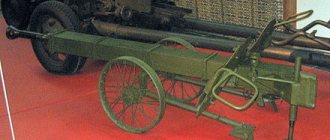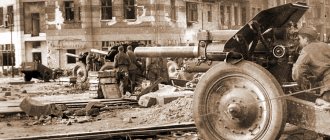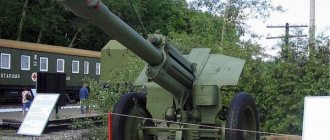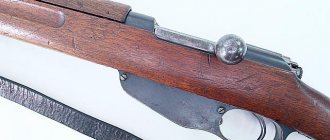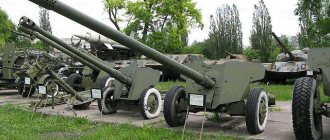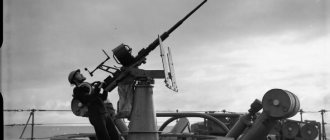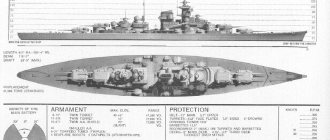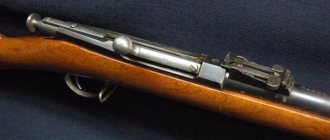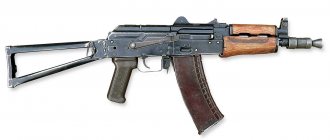Hit “tanks” and “panthers” from ambushes
In addition, the ZIS-3 had a very important advantage in anti-tank use - the gun did not bury itself when firing into the ground, like many German guns. This allowed the crew to quickly respond to danger from all sides, and, if necessary, quickly roll the artillery installation after their advancing infantry
With the appearance of “tigers”, “panthers” and heavy self-propelled artillery mounts on the battlefield in 1943, these German armored vehicles turned out to be invulnerable to ZIS-3 fire when firing at the frontal armor. However, Soviet artillerymen began to actively use ambush tactics, shooting the enemy with shots at less protected sides.
After the Red Army introduced sub-caliber and cumulative shells, the anti-tank properties of the ZIS-3 improved, allowing the gun to confidently penetrate 80 mm frontal armor at distances closer than 500 meters. However, the Germans did not have many heavy tanks, and the 76-mm gun dealt with the rest of the enemy armored vehicles perfectly until the end of the war.
76-mm divisional gun ZIS-3
This divisional gun actually has a slightly larger caliber than the 76.2 stated in its name. It was designed and produced in 1942. Time will tell that this gun is destined to become a replacement for many artillery system guns that were in service in the Red Army at that time, to make up for the terrible damage caused by German troops. The developed project of an artillery gun, ZIS-3, was a simple, durable unit without unnecessary technical additions. It could be put into serial production immediately and provide thousands of units to all army units. Since the collapse of the Union, this type of gun is no longer stationed on the borders of the Eastern Bloc. And the block itself no longer exists. However, the countries of the so-called third world willingly continue to use the gun in their military units. For example, in China they serve as both the main type and a modernized version.
And our former republics, unfortunately, left such a simple but convenient technical military unit only as a ceremonial sign at significant state parades and in the symbolic decoration of state administrations. ZIS-3 also takes part in fireworks displays. Romanian industrialists continue to produce shells for this type of weapon, although every year the geography of its use shrinks and becomes irrelevant.
Technically, as already mentioned, the weapon is very simply designed. It stands on a carriage base, has sliding tubular frames, and covers its crew with a large shield. The trunk is tall and thin. As field artillery, the ZIS-3 also carried out anti-tank resistance. Why did they install a more powerful barrel on one of the modifications? This was in 1943. Over the course of a long time, the use of artillery guns has gone through a rather long and long path of development and has undergone many changes. However, such a principle of simplicity and quality was maintained that it was never considered scrap or obsolete. Only aggressive attacks by the military-industrial complex of NATO countries pushed this type of military equipment into the background.
A high degree of quality of the models was achieved by a wide range of applications through constant modernization and improvement of this type of artillery pieces. The standardization of the combat arsenal with such a weapon has not lost its degree to this day. High-explosive fragmentation shells continue to be fired at the same level as an armor-piercing destroyer. Over time, the production of long-range cumulative projectiles, which are capable of penetrating armor protection 19.5 cm thick, was mastered and introduced. With all this, the average firing range is 13 km. However, simplicity, as we know, is the key to success.
German view of the Soviet gun
From the very first days of the ZIS-3's appearance on the battlefield, Wehrmacht soldiers experienced the damaging effects of its fragmentation and shrapnel shells, which were superior to those of foreign guns of similar calibers. Fortunately, the Soviet divisional artillery fired, as a rule, from a short distance of 3-5 kilometers.
As for tanks, before the start of the Kursk Bulge, the ZIS-3 freely hit almost all enemy armored vehicles head-on from a distance of 700-900 meters.
German artillery designers, comparing the technical level of the ZIS-3 with their 75 mm guns, came to the conclusion that the Soviet gun was undoubtedly superior. It was superior to enemy artillery in a number of parameters. In particular, in terms of the ratio of muzzle energy to the weight of the gun in the firing position and at the maximum firing range, moreover, the projectile sent was 13% heavier than the German one.
A weapon with a woman's name
The range of tasks of the ZIS-3 was very extensive. The gun was intended to destroy enemy infantry, his machine guns and artillery, tanks and armored vehicles, and destroy long-term enemy firing points. At all these targets, the gun fired a varied assortment of cannon shells - from high-explosive fragmentation grenades that pierced a 75-centimeter brick wall, to cumulative shells that burned through the armor of German tanks up to 90 millimeters thick.
Having soon found its way into the active army, the ZIS-3 gun received various nicknames from the artillerymen. Some affectionately called the gun by the feminine name “Zosya” for its reliability and simplicity, while others called it “Volley named after Stalin” for its rate of fire and excellent combat characteristics.
The Germans also awarded the Soviet division a nickname - Ratsch-bumm - due to the fact that the sound of a projectile flying at supersonic speed was heard a little earlier than the roar of the shot.
Bright symbol of Victory
In 1943, two more plants actively joined the production of the division - No. 235 in Votkinsk and No. 13 in Ust-Katav. This happened after during the battles it became clear the need to create self-propelled artillery that would support tank forces. The ZIS-3 began to be installed on the developed SU-76 self-propelled gun.
Its combat debut took place on the Kursk Bulge, where Soviet artillerymen burned many enemy tanks. The modification of this self-propelled gun in the form of the SU-76M became the most popular Soviet self-propelled gun. During the war, 11 thousand 494 vehicles were produced.
As for the ZIS-3 itself, a total of 48,016 guns were produced, which is more than the production of any other gun in the entire history of mankind. Along with the T-34 tank and the Il-2 aircraft, the 76-mm divisional gun of the 1942 model became one of the brightest symbols of the victory of the Red Army in the Great Patriotic War.
